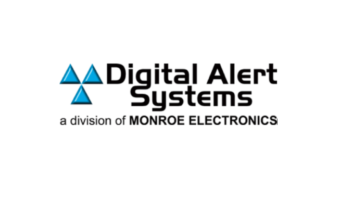Applied Technology: GSS Alert FM
Apr 1, 2010 12:00 PM, By Matthew Straeb
FM radio-based alert and messaging systems enable emergency management personnel to create and send radio data alerts and messages to targeted recipients. The single-point to multi-point messaging functionality utilizes the overlapping data signal of existing FM stations to provide redundant emergency notification capability. These systems can deliver emergency information through FM data subcarriers, SMS (text messaging) to mobile phones, and e-mail. They are a great complement to outdoor warning sirens or telephone-based mass notification systems whose performance can be adversely affected by clogging and power outages, which occur in emergencies. FM radio-based alert systems can distribute messages received countywide in less than 60 seconds.

Dedicated receivers like this wall-mount unit can provide FM-based emergency alerts.
Message origination and system administration is handled through a Web-based portal, which can be accessed via any secure Internet connection. The portal allows the users to create groups and subgroups based on geographic or organizational classification. Messages can be pre-scripted or canned as well as custom-made. The portal also features the history of all messages including the sender, specific content, time and date stamp, and destination. An automated data feed for National Weather Service warnings mean users can program their receivers to get these local weather warnings.
All FM radio-based alert systems servers are hosted in reputable, third-party data hosting centers and accessible by secure login. Data is backed up each night using a third-party data archiving service. These systems feature data communications using satellites in addition to terrestrial Internet, which allows for full system operations even if power is interrupted at the emergency operations center or at an FM transmitter. This satellite data transmission between the servers and the FM stations also adds a security layer to the system. The entire system is closed between the administrative portal, where the data is entered, and the receivers.
The FM chip

Alerts can also be received on portable devices with FM receivers.
The FM chip is one key to interoperability. This single-to-multi-point radio broadcast system uses the Radio Broadcast Data System (RBDS) subcarrier datacasting, layered in need-to-know groupings based on an existing communication infrastructure � the country’s nationwide FM broadcasting network. Targeted alerts and messages are delivered by satellite to FM transmission towers and can be received on Alert FM receivers and other mobile devices. Millions of Americans, including countless first-responders and public safety workers, have the potential to receive alerts and time critical information with the activation of the standard FM chip.
Most people are still surprised when cell networks cannot handle the extra load during emergencies. The reality is that cell phone networks are switched (point-to-point) and were not designed to handle the loads put on them today. Even more alarming is the lack of awareness that wireless carriers have the potential to further safeguard individuals and communities with the activation of a standard FM receiver chip that exists in most cellular handsets today, which is capable of receiving personal alert messages from a standard FM radio tower used to listen to your favorite music. This capability can be used while not interfering with normal cell phone usage.
— continued on page 2
Applied Technology: GSS Alert FM
Apr 1, 2010 12:00 PM, By Matthew Straeb
FM chips are readily available for insertion into cell phones and are used extensively outside the US. The consumers are offered easy access to FM stations and data via the open service business model adopted in Europe and Asia. This means the carriers provide the service and offer users a la carte services without tying them to a particular phone or cell service. This has resulted in more than 40 percent of the market using FM radio and receiving important data using the cell phone. Secondly, the technical barriers of battery drain and internal antennas have been overcome. The chips available provide signal sensitivity capable of tuning and receiving FM radio signals without external headset antennas. Coupled with tuning and battery-saving software, the tuner wakes and goes back to sleep. The same software is used in GPS receivers, NOAA weather data receivers, alert receivers, smoke detectors and other consumer devices to preserve battery life.

Board of FM receiver with internal antenna
Currently, a FEMA study program is in place to provide global government adoption of the FM radio-based alert technology and applications into the Integrated Public Alert and Warning System Infrastructure. As part of this adoption, FM radio-based alert products will be added to the IPAWS qualified products list (as a message disseminator) and eligible for deployment across the United States.
Fixed and mobile

An FM radio-based mobile receiver can receive alerts including NOAA weather warnings, homeland security notices, evacuation instructions, Amber Alerts or school closings.
Today FM radio-based alert systems can feature fixed and/or mobile receivers. The receivers are programmable for up to 30 groups and services, have siren- and text-alert capabilities, and powered by a combination of battery and ac power. They are capable of receiving messages from any FM station on its network, so customers, may use their receivers anywhere there is GSS FM coverage. This feature is particularly beneficial during evacuations.
These systems can be fully CAP compliant, which will allow for full integration with third-party systems such as reverse 911 telephone systems or sirens. Many times a user will already have other notification technologies and he wants the new FM radio notification capability added to his existing system. This integration capability and open architecture allows these systems to be expanded into new applications in the future. They can also be activated via existing alert and warning systems.
Support groups
As emergency communication channels continue to receive scrutiny, the role of broadcasters will advance as the FM network infrastructure is considered to provide efficient and solid support for the vigorous delivery of time critical, life-saving messages.
— continued on page 3
Applied Technology: GSS Alert FM
Apr 1, 2010 12:00 PM, By Matthew Straeb
Specifically, the Commercial Mobile Alert Services Advisory, born out of the Warning Alert Response Network Act (WARN Act) to facilitate the wireless devices such as cell phones to adopt alerting technologies. The Federal Communications Commission took a number of steps in facilitating the ability of consumers to receive emergency alerts through their wireless phones. In 2008, the Commission issued a series of orders adopting requirements for a Commercial Mobile Alert System (CMAS), a system by which commercial mobile service (CMS) providers may transmit emergency alerts to their subscribers.
A Consumer Electronics Association industry-working group (R6 WG16 Fixed and Mobile Alert Warning Devices) has been established to provide best practices and guidelines receive Common Alert Protocol (CAP) alert data and use on fixed and mobile consumer electronics devices.

FM radio-based alert system diagram Click image to enlarge.
As officials and the public consider alternatives to cellular voice calls, text messaging is frequently discussed as a safe alternative during emergencies. Text messaging, including applications based on Short Message Service protocol, is its own worst enemy during a perceived or real emergency. Network overload and inoperability are problematic, and there is a security issue due to the dependence on Internet connectivity to interconnect the communications channel.
The cell network infrastructure is vulnerable, connected to a maze of landline telephone switches, and encryption is not supported all the way to the wireless receiver. In comparison, FM radio-based alert systems use a dedicated satellite and secured channels so there is no possibility of public access to the network. In a crisis, these systems have a guaranteed channel that offers protective umbrella coverage for certified command and controlled messages to be delivered with a guaranteed source and encryption all the way to the receiver. Satellite coverage is essential to bridge the post-disaster communications breakdown that occurs after every significant hurricane or earthquake.
As broadcasters remain on the front lines of providing emergency information to their audiences, it is exciting for stations to be a part of the existing EAS, as well as new initiatives designed to provide a more comprehensive solution for emergency communication.
Straeb is executive vice president of Global Security Systems, Jackson, MS.
For an update on current FEMA IPAWS projects, visitwww.fema.gov/emergency/ipaws/systemenhancements.shtm












